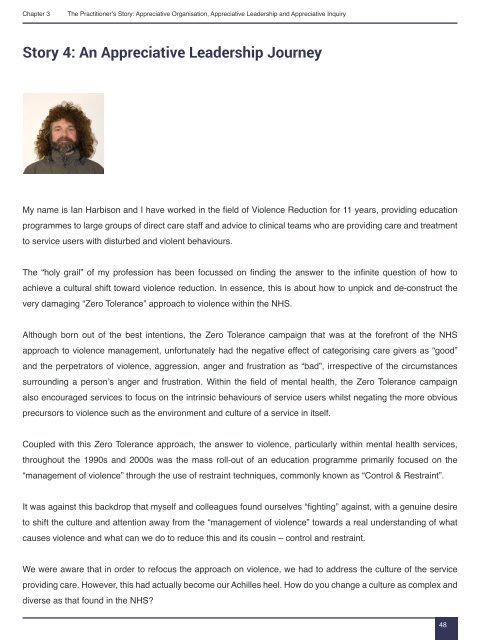Appreciative-Leadership
Appreciative-Leadership
Appreciative-Leadership
Create successful ePaper yourself
Turn your PDF publications into a flip-book with our unique Google optimized e-Paper software.
Chapter 3<br />
The Practitioner’s Story: <strong>Appreciative</strong> Organisation, <strong>Appreciative</strong> <strong>Leadership</strong> and <strong>Appreciative</strong> Inquiry<br />
Story 4: An <strong>Appreciative</strong> <strong>Leadership</strong> Journey<br />
My name is Ian Harbison and I have worked in the field of Violence Reduction for 11 years, providing education<br />
programmes to large groups of direct care staff and advice to clinical teams who are providing care and treatment<br />
to service users with disturbed and violent behaviours.<br />
The “holy grail” of my profession has been focussed on finding the answer to the infinite question of how to<br />
achieve a cultural shift toward violence reduction. In essence, this is about how to unpick and de-construct the<br />
very damaging “Zero Tolerance” approach to violence within the NHS.<br />
Although born out of the best intentions, the Zero Tolerance campaign that was at the forefront of the NHS<br />
approach to violence management, unfortunately had the negative effect of categorising care givers as “good”<br />
and the perpetrators of violence, aggression, anger and frustration as “bad”, irrespective of the circumstances<br />
surrounding a person’s anger and frustration. Within the field of mental health, the Zero Tolerance campaign<br />
also encouraged services to focus on the intrinsic behaviours of service users whilst negating the more obvious<br />
precursors to violence such as the environment and culture of a service in itself.<br />
Coupled with this Zero Tolerance approach, the answer to violence, particularly within mental health services,<br />
throughout the 1990s and 2000s was the mass roll-out of an education programme primarily focused on the<br />
“management of violence” through the use of restraint techniques, commonly known as “Control & Restraint”.<br />
It was against this backdrop that myself and colleagues found ourselves “fighting” against, with a genuine desire<br />
to shift the culture and attention away from the “management of violence” towards a real understanding of what<br />
causes violence and what can we do to reduce this and its cousin – control and restraint.<br />
We were aware that in order to refocus the approach on violence, we had to address the culture of the service<br />
providing care. However, this had actually become our Achilles heel. How do you change a culture as complex and<br />
diverse as that found in the NHS<br />
48


